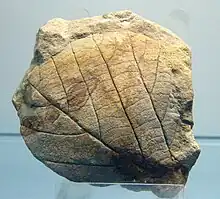| Credneria Temporal range: | |
|---|---|
 | |
| Credneria triacuminata leaf | |
| Scientific classification | |
| Kingdom: | Plantae |
| Clade: | Tracheophytes |
| Clade: | Angiosperms |
| Clade: | Eudicots |
| Order: | Proteales |
| Family: | Platanaceae |
| Genus: | †Credneria Zenker |
Credneria is an extinct genus in the family or Platanaceae[1][2][3] of broad-leaf trees similar to extinct Platanus species that appeared during the Cretaceous. The genus was first described by Zenker (1833) and has formerly been placed in the family Salicaceae[4] rather than Platanaceae on occasion. Credneria leaves are preserved in sandstone and less often in siltstone. The leaves are typically obovate with a pinnate-actinodromous venation and distinct suprabasal veins.[5]
Species
Known species are:[6][4][7][8]
- Credneria biloba
- Credneria bohemica
- Credneria comparabilis [9]
- Credneria cuneifolia
- Credneria daturaefolia (Ward) [10]
- Credneria denticulata [11]
- ?Credneria grewiopsoides [12]
- Credneria integerrima
- ?Credneria longifolia
- Credneria pachyphylla
- Credneria parva
- Credneria prophylloides (Knowlton)
- Credneria pulchra
- ?Credneria spatiosa
- Credneria subserrata (Hampe)
- Credneria subtriloba
- Credneria sudanense
- Credneria triacuminata (Hampe)
The species Crednetia basinervosa (Hollick),[13] C. elegans (Hollick),[14] C. inordinata (Hollick), C. intermedia (Hollick), C. mixta(Hollick), and C. truncatodenticulata (Bell) have all been identified as junior synonyms of the platanaceous species Pseudoprotophyllum boreale.[15] The species Credneria grewiopsoides (Hollick), C. longifolia (Hollick) and C. spatiosa (Hollick) from the Cenomanian Melozi and Kaltag formations along the Yukon River in Alaska are also possibly representatives of Pseudoprotophyllum boreale, but the known fossil material for the species was considered to incomplete to make a determination.[15]
References
- ↑ Thomas Denk & Maria V. Tekleva (2006). "Comparative pollen morphology and ultrastructure of Platanus: Implications for phylogeny and evaluation of the fossil record". Grana. 45:3 (3): 195–221. doi:10.1080/00173130600873901.
- ↑ Collinson, Margaret E (1992). "The early fossil history of Salicaceae: a brief review". Proceedings of the Royal Society of Edinburgh, Section B: Biological Sciences. 98: 155–167. doi:10.1017/S0269727000007521.
- ↑ Wang, H.; Dilcher, D. (2018). "Early Cretaceous angiosperm leaves from the Dakota Formation, Hoisington III locality, Kansas, USA". Palaeontologia Electronica. 21 (3). doi:10.26879/841.
- 1 2 "Credneria Zenker, 1833".
- ↑ Georg F. Tschana; Thomas Denka; Maria von Balthazara (2008). "Credneria and Platanus (Platanaceae) from the Late Cretaceous (Santonian) of Quedlinburg, Germany". Review of Palaeobotany and Palynology. 152 (3–4): 211–236. doi:10.1016/j.revpalbo.2008.05.004.
- ↑ Halamski, A. (2013). "Latest Cretaceous leaf floras from southern Poland and western Ukraine" (PDF). Acta Palaeontologica Polonica. 58 (2): 407–443.
- ↑ P. B. Richter (1905). Über die Kreidepflanzen der Umgebung Quedlinburgs (PDF). Archived from the original (PDF) on 2017-04-25. Retrieved 2017-04-24.
- ↑ Knobloch E. (1997). ""Credneria" bohemica Velenovský – eine altertümliche Platane". Palaeontographica B. 1242: 127–148.
- ↑ "Credneria comparabilis Hollick".
- ↑ "Credneria daturaefolia Ward".
- ↑ "Credneria denticulata".
- ↑ "Credneria grewiopsoides Hollick".
- ↑ "Credneria basinervosa Hollick".
- ↑ "Credneria elegans Hollick".
- 1 2 Golovneva, L. B. (2009). "The morphology, taxonomy, and occurrence of the genus Pseudoprotophyllum Hollick (Platanaceae) in Late Cretaceous floras of Northern Asia". Paleontological Journal. 43 (10): 1230–1244.